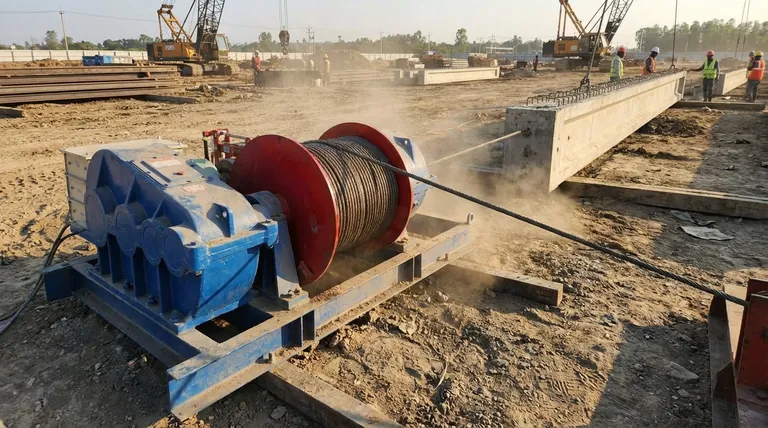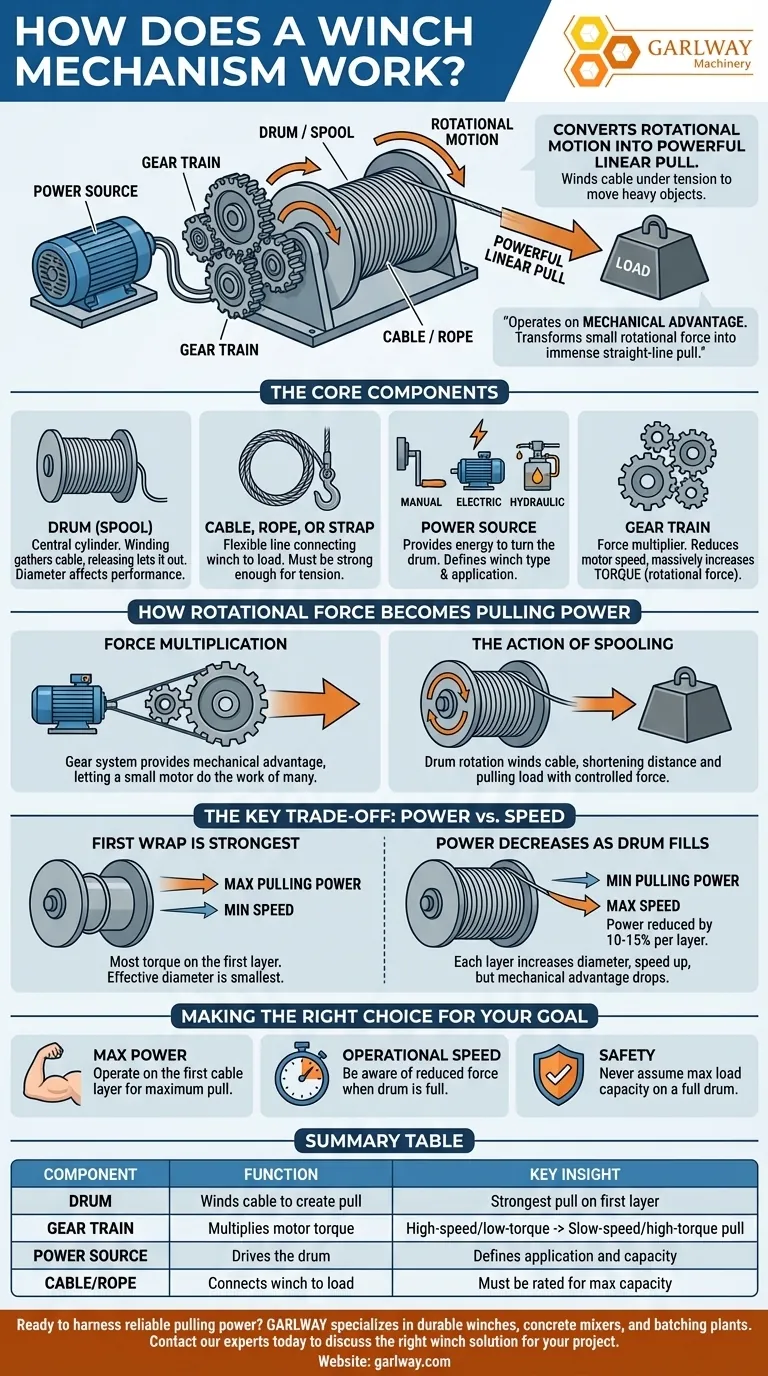At its core, a winch is a mechanical device that converts rotational motion into a powerful linear pull. It works by winding a cable, rope, or strap around a rotating drum. A motor or a manual crank turns this drum, and as the cable wraps around it, the tension created is strong enough to lift or drag heavy objects.
A winch operates on the principle of mechanical advantage. By using a motor and gear system to rotate a central drum, it winds a cable under tension. This action transforms a small, manageable rotational force into a powerful, straight-line pull capable of moving loads far heavier than the input force could move on its own.

The Core Components and Their Roles
A winch appears simple, but its effectiveness comes from the interaction of a few key parts. Understanding each component's function clarifies the entire mechanism.
The Drum (or Spool)
The drum is the central cylinder that the cable winds onto. When the drum rotates, it either gathers the cable (pulling the load in) or releases it (letting the load out). Its diameter is a critical factor in the winch's performance.
The Cable, Rope, or Strap
This is the flexible line that connects the winch to the load. It must be strong enough to handle the tension generated. One end is anchored to the drum, while the other connects to the object being moved.
The Power Source
This is what provides the energy to turn the drum. The type of power source defines the type of winch and its typical application.
- Manual: A hand crank that the operator turns.
- Electric: An electric motor, often powered by a vehicle's battery.
- Hydraulic: A hydraulic pump that uses pressurized fluid to drive a motor, common in heavy industrial equipment.
The Gear Train
Between the power source and the drum lies a system of gears. The gear train is the true force multiplier, reducing the speed of the motor's rotation but massively increasing its torque, which is the rotational force applied to the drum.
How Rotational Force Becomes Pulling Power
The genius of the winch is in its conversion of energy. A high-speed, low-torque rotation from a motor is transformed into a slow-speed, high-torque rotation at the drum, resulting in an immense linear pull.
The Principle of Force Multiplication
Imagine trying to pull a heavy vehicle by hand versus using a winch. The winch's gear system provides mechanical advantage, allowing a small electric motor to do the work of many people. This is why a compact device can move thousands of pounds.
The Action of Spooling
When the winch is activated, the power source turns the gears, which in turn rotate the drum. The drum's rotation neatly winds the cable upon itself, shortening the distance between the winch and the load and pulling the load with steady, controlled force.
Understanding the Key Trade-off: Power vs. Speed
A winch's performance is not constant. A critical relationship exists between the amount of cable on the drum and the winch's pulling power, which is a common point of misunderstanding.
The First Wrap is the Strongest
A winch delivers its maximum rated pulling power when the cable is almost fully extended. At this point, only the first layer of cable is on the drum. The drum's effective diameter is at its smallest, providing the most torque and the strongest pull.
Power Decreases as the Drum Fills
As more cable is wound onto the drum, each new layer increases the drum's effective diameter. This has two effects:
- Pulling speed increases: The drum pulls in more cable with each rotation.
- Pulling power decreases: The mechanical advantage is reduced, and the winch can't pull as hard.
A winch might lose 10-15% of its pulling power for each additional layer of cable wrapped on the drum. This is why the rated capacity is always based on that first, most powerful wrap.
Making the Right Choice for Your Goal
Understanding how a winch works allows you to use it more effectively and safely. Your goal will dictate how you approach its operation.
- If your primary focus is maximum pulling power: Use the winch with as much cable spooled out as is safely possible to operate on the first layer.
- If your primary focus is operational speed: Be aware that you sacrifice significant pulling force when the drum is nearly full of cable.
- If your primary focus is safety: Never assume the winch can pull its maximum rated load when the cable is mostly wound onto the drum.
By grasping these core principles, you can use a winch not just as a tool of brute force, but as a precise instrument for applying controlled power.
Summary Table:
| Component | Function | Key Insight |
|---|---|---|
| Drum | Winds the cable to create pull | Pulling power is strongest on the first layer of cable |
| Gear Train | Multiplies motor torque | Transforms high-speed, low-torque rotation into powerful, slow-speed pull |
| Power Source | Drives the drum (Electric, Hydraulic, Manual) | Defines the winch's application and capacity |
| Cable/Rope | Connects the winch to the load | Must be rated for the winch's maximum pulling capacity |
Ready to harness reliable pulling power for your construction or contracting needs?
GARLWAY specializes in engineering durable and powerful winches, concrete mixers, and batching plants for professionals like you. Our equipment is designed to deliver the controlled force and safety you need to move heavy loads efficiently.
Contact our experts today to discuss the right winch solution for your specific project requirements.
Visual Guide

Related Products
- Electric Hoist Winch Boat Anchor Windlass for Marine Applications
- Small Electric Winch 120V and 240V for Compact Applications
- Electric 120V Boat Winch by Badlands
- Warn Winch Windlass Boat Trailer Winch
- Heavy Duty Electric Boat Winch Windlass Anchor
People Also Ask
- How do electric hoists provide precise load control? Achieve Safe & Accurate Lifting
- What are the advantages of an electrically operated trailer winch? Enhance Safety & Control for Your Trailer
- What are the key precautions to follow when using an electric hoist? Ensure Safe and Efficient Lifting Operations
- What are the pros and cons of electrical winches? Make the Right Choice for Your Project
- How should the hoist winch be debugged after installation? A 3-Phase Guide to Ensure Safety & Reliability



















